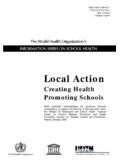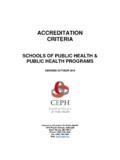Transcription of Health-promoting schools: an opportunity for oral …
1 677 Bulletin of the world health organization | September 2005, 83 (9)Abstract Schools provide an important setting for promoting health , as they reach over 1 billion children worldwide and, through them, the school staff, families and the community as a whole. health promotion messages can be reinforced throughout the most influential stages of children s lives, enabling them to develop lifelong sustainable attitudes and skills. Poor oral health can have a detrimental effect on children s quality of life, their performance at school and their success in later life. This paper examines the global need for promoting oral health through schools. The WHO Global school health Initiative and the potential for setting up oral health programmes in schools using the Health-promoting school framework are discussed. The challenges faced in promoting oral health in schools in both developed and developing countries are highlighted. The importance of using a validated framework and appropriate methodologies for the evaluation of school oral health projects is Oral health ; Oral hygiene; Schools; school health services; health education, Dental; Food services; health behavior; health promotion/methods; health policy (source: MeSH, NLM).
2 Mots cl s Hygi ne buccale; Hygi ne bucco-dentaire; Etablissement scolaire; Education sanitaire dentaire; Service hygi ne scolaire; Restauration; Hygi ne de vie; Promotion sant /m thodes; Politique sanitaire (source: MeSH, INSERM).Palabras clave Salud bucal; Higiene bucal; Servicios de salud escolar; Escuelas; Educaci n en salud dental; Servicios de alimentaci n; Conducta de salud; Promoci n de la salud/m todos; Pol tica de salud (fuente: DeCS, BIREME).Bulletin of the world health organization 2005;83 page 684 le r sum en fran ais. En la p gina 684 figura un resumen en espa Dental Public health , Leeds Dental Institute, Clarendon Way, Leeds LS2 9LU, England. Correspondence should be sent to this author (email: Oral health Programme, world health organization , Geneva, Department of Clinical Dental Sciences, school of Dentistry, University of Liverpool, Department of Preventive Dentistry, Dental school of Erfurt, Friedrich-Schiller University of Jena, No.)
3 04-020305(Submitted: 18 February 2005 Final revised version received: 24 June 2005 Accepted: 27 June 2005) Health-promoting schools: an opportunity for oral health promotionStella Kwan,1 Poul Erik Petersen,2 Cynthia M. Pine,3 & Annerose Borutta4 IntroductionOral health is fundamental to general health and well-being. A healthy mouth enables an individual to speak, eat and socialize without experiencing active disease, discomfort or embarrass-ment. Children who suffer from poor oral health are 12 times more likely to have restricted-activity days than those who do not (1). More than 50 million school hours are lost annually because of oral health problems which affect children s perfor-mance at school and success in later life (2).Schools provide an effective platform for promoting oral health because they reach over 1 billion children worldwide. The health and well-being of school staff, families and com-munity members can also be enhanced by programmes based in schools (3).
4 Oral health messages can be reinforced through-out the school years, which are the most influential stages of children s lives, and during which lifelong beliefs, attitudes and skills are developed. This article examines the potential for promoting oral health through schools, based on the WHO Health-promoting school (HPS) for oral health promotion in schoolsOral disease can lead to pain and tooth loss, a condition that af-fects the appearance, quality of life, nutritional intake and, con-sequently, the growth and development of children. The bur-den of oral disease is considerable. Tooth decay and gum disease are among the most widespread conditions in human popula-tions, affecting over 80% of schoolchildren in some countries (4 6). The prevalence of other oral disorders such as dental erosion and enamel defects is rising (5, 6). Many children have experienced oral trauma, a substantial proportion of whom are under the age of 5 years (7). Some tobacco-containing products are marketed directly at children and adolescents; people who start consuming these products at an early age may have an increased risk of oral cancer in later life (8).
5 Noma, a devastat-ing and potentially life-threatening condition, affects a large number of children in Africa, Asia and Latin America (9).Oral disease is one of the most costly diet- and lifestyle-related diseases (10, 11). The cost of treating dental decay alone could easily exhaust a country s total health care budget for children (12). However, the cost of neglect is also high in terms of its financial, social and personal impacts (13).Many oral health problems are preventable and their early onset reversible. However, in several countries a considerable number of children, their parents and teachers have limited knowledge of the causes and prevention of oral disease (14 17), 678 Bulletin of the world health organization | September 2005, 83 (9)Special Theme Oral HealthOral health in Health-promoting schools Stella Kwan et by a lack of affordable fluoride toothpaste and poor access to oral health care. The problems are exacerbated by the consumption of sugary snacks and carbonated drinks which is high among children and adolescents (18).
6 Given that many risk behaviours stem from the school -age years, schools have powerful influences on children s devel-opment and well-being (18 20). The need for the promotion of oral health in schools is evident and it can easily be integrated into general health promotion, school curricula and activities. Children can be provided with skills that enable them to make healthy decisions, to adopt a healthy lifestyle and to deal with conflicts. Healthy behaviours and lifestyles developed at a young age are more sustainable. Messages can be reinforced throughout the school school health InitiativeBased on the guiding principles of the Ottawa Charter for health Promotion and the recommendations of WHO s Expert Committee on Comprehensive school health Education and Promotion, the WHO Global school health Initiative was launched in 1995. The Initiative aims to foster Health-promoting Table 1. Examples of oral health -related school health policiesPolicy areas Examples of issues for considerationHealthy school Safe and well-designed school buildings and playgrounds to prevent injuries and avoid sick building syndrome environment No smoking on the school premises Fluoridation ( of milk) A ban on the sale of unhealthy or harmful foods and substances in the close vicinity of the school Safe water and good sanitation facilities A caring and respectful psychosocial environment A protocol for dealing with bullying and violent behaviour, as well as interpersonal conflictsHealthy eating Healthy foods must be made available in the school canteen, tuck shop, kiosks and vending machines Only nutritious meals are served in the school canteen Promotion of 5-a-day (fruit and vegetables)
7 A Drinking-water fountains throughout the school Training for cooks and food providers Assessment and surveillance of nutritional statusNo sugar A ban on sugary foods and drinks on the school premisesNo alcohol A ban on alcohol consumption on the school premisesNo smoking A ban on smoking on the school premises Smoking cessation services and counsellingOral health education Oral health education should form part of all subjects in the school curriculum Daily supervised toothbrushing drills Training for parents about good oral health and encouragement for them to take part in health promotion activities at school Training for school staffOral health service Working closely with central or local oral health service providers Dealing with dental emergencies Role of teachers in oral health surveillance, screening and basic treatment, ARTb Monitoring of oral health -related complaints and absenteeism. Training for school staffOral injury Accident prevention Clear protocol of vital actions to be taken without delay Monitoring incidence of oral traumaPhysical exercise Commitment to provide safe facilities for training in sport and leisure activities Exercise and physical education are a compulsory part of the school curriculum A protocol on safe sport, use of mouth guardsControl of cross-infection Clear guidelines on how to control cross-infection Training for school staffPolicy development Training for developing policies and action plans Students, school staff, families and community members are to be involved in the planning, development and review process school health team, community advisory committee, PTAc and school governors should meet at least 4 times a yearOthers school ethos Commitment to an integrated school community The role of school in supporting local health issues.
8 Water fluoridation Support for school - or community-based health promotion activities such as breakfast clubsa Programme to encourage consumption of at least five servings of fruit and vegetables per day. b ART, atraumatic restorative technique. c PTA, parent-teacher of the world health organization | September 2005, 83 (9)Special Theme Oral HealthStella Kwan et al. Oral health in Health-promoting schools schools (HPSs); these are schools that constantly strengthen their capacity as a healthy setting for living, learning and working (21). It seeks to mobilize and strengthen health promotion and education activities through schools to improve the health of students, school staff, families and the Initiative comprises four key strategies, namely, building capacity to advocate for improved school health pro-grammes; creating networks and alliances for the development of HPSs; strengthening national capacity; and research to improve the effectiveness of school health programmes.
9 The Initiative helps countries develop strategies and collaboration between health and education agencies as well as programmes to improve health through schools. Global, regional and local networks have been developed to enable schools to share their experiences. Numerous technical reports have been published by WHO since 1995 to help schools to become up oral health programmes in schoolsUsing the structures and systems already in place, a school is an efficient setting for the promotion of oral health . Promotion of oral health can trigger the installation of vital facilities such as safe water and sanitation. Initiatives that adopt the HPS strategies are effective, leading to potential long-term cost savings (22). The key components of an HPS are healthy school environment, school health education, school health services, nutrition and food services, physical exercise and leisure activities, mental health and well-being, health promotion for staff and community relation-ships and collaboration.
10 Each area offers many opportunities for addressing oral health issues either as a specific project or as part of a general health promotion strategy. It is crucial that these initiatives are supported by school health policies (Table 1). Although a specific policy can be developed to tackle a single issue, it may be useful to address several problems or a number of risk factors in a single school environmentOral health can be promoted through initiatives that aim at providing a supportive school environment. Safe playgrounds and buildings together with a smoke-free and stress-free envi-ronment and the availability of healthy foods can help reduce the risk to oral and general health and promote sustainable healthy lifestyles. A ban on selling unhealthy snacks in schools could be a starting point. Safe water and sanitation facilities are essential for toothbrushing drills and for controlling cross-infection. Oral health promotion should also address the sale of unhealthy foods and drinks and of tobacco-containing products to students in the vicinity of school health educationProviding education on oral health in schools helps children to develop personal skills, provides knowledge about oral health and promotes positive attitudes and healthy behaviours.














